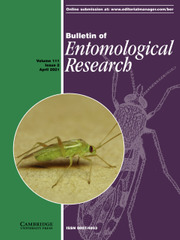Ver ítem
- xmlui.general.dspace_homeCentros e Institutos de InvestigaciónCICVyA. Centro de Investigación en Ciencias Veterinarias y AgronómicasInstituto de GenéticaArtículos científicosxmlui.ArtifactBrowser.ItemViewer.trail
- Inicio
- Centros e Institutos de Investigación
- CICVyA. Centro de Investigación en Ciencias Veterinarias y Agronómicas
- Instituto de Genética
- Artículos científicos
- Ver ítem
Host discrimination in the fruit fly parasitoid Diachasmimorpha longicaudata : evidence from virgin female behaviour and egg distribution patterns
Resumen
Many parasitoid species discriminate already parasitized hosts, thus avoiding larval competition. However, females incur in superparasitism under certain circumstances. Superparasitism is commonly observed in the artificial rearing of the parasitoid Diachasmimorpha longicaudata, yet host discrimination has been previously suggested in this species. Here, we addressed host discrimination in virgin D. longicaudata females in a comprehensive way by means of
[ver mas...]
Many parasitoid species discriminate already parasitized hosts, thus avoiding larval competition. However, females incur in superparasitism under certain circumstances. Superparasitism is commonly observed in the artificial rearing of the parasitoid Diachasmimorpha longicaudata, yet host discrimination has been previously suggested in this species. Here, we addressed host discrimination in virgin D. longicaudata females in a comprehensive way by means of direct and indirect methods, using Ceratitis capitata and Anastrepha fraterculus which are major fruit fly pests in South America. Direct methods relied on the description of the foraging behaviour of females in arenas with parasitized and non-parasitized host larvae. In the indirect methods, healthy larvae were offered to single females and the egg distributions were compared to a random distribution. We found that D. longicaudata was able to recognize parasitized host from both host species, taking 24 h since a first parasitization for A. fraterculus and 48 h for C. capitata. Indirect methods showed females with different behaviours for both host species: complete discrimination, non-random (with superparasitism), and random distributions. A larger percentage of females reared and tested on A. fraterculus incurred in superparasitism, probably associated with higher fecundity. In sum, we found strong evidence of host discrimination in D. longicaudata, detecting behavioural variability associated with the host species, the time since the first parasitization and the fecundity of the females.
[Cerrar]

Fuente
Bulletin of Entomological Research 111 (2) : 229-237 (Abril 2021)
Fecha
2021-04
Editorial
Cambridge University Press
ISSN
0007-4853
URI
http://hdl.handle.net/20.500.12123/9102
https://www.cambridge.org/core/journals/bulletin-of-entomological-research/article/abs/host-discrimination-in-the-fruit-fly-parasitoid-diachasmimorpha-longicaudata-evidence-from-virgin-female-behaviour-and-egg-distribution-patterns/2AB8A0FDACF57FEDE787FCF3AFD4A4B0
https://www.cambridge.org/core/journals/bulletin-of-entomological-research/article/abs/host-discrimination-in-the-fruit-fly-parasitoid-diachasmimorpha-longicaudata-evidence-from-virgin-female-behaviour-and-egg-distribution-patterns/2AB8A0FDACF57FEDE787FCF3AFD4A4B0
Formato
pdf
Tipo de documento
artículo
Palabras Claves
Derechos de acceso
Restringido
 Excepto donde se diga explicitamente, este item se publica bajo la siguiente descripción: Creative Commons Attribution-NonCommercial-ShareAlike 2.5 Unported (CC BY-NC-SA 2.5)
Excepto donde se diga explicitamente, este item se publica bajo la siguiente descripción: Creative Commons Attribution-NonCommercial-ShareAlike 2.5 Unported (CC BY-NC-SA 2.5)

